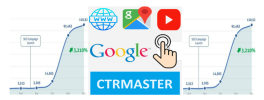Boost Your CTR With Cutting-Edge Adjustment Approaches
In today's affordable digital landscape, raising your click-through rate (CTR) needs a nuanced understanding of individual psychology and ingenious manipulation methods. As we check out these cutting-edge methods, it comes to be evident that the key to unlocking higher conversion prices exists not simply in the techniques themselves, however in exactly how they are applied.
Recognizing User Psychology
Understanding individual psychology is crucial for optimizing click-through rates (CTR), as it looks into the inspirations and actions that drive users to involve with web content. By understanding the cognitive processes and emotional triggers that influence decision-making, marketers can create more reliable approaches focused on catching customer rate of interest.
One trick facet of customer psychology is the principle of cognitive prejudices, which are organized patterns in assuming that affect judgment and habits. For example, the scarcity concept suggests that individuals are most likely to act when they view limited schedule. This principle can be leveraged to develop a feeling of seriousness, motivating individuals to click on an offer before it expires.
Additionally, understanding the duty of social proof is vital. Individuals frequently look to the activities and point of views of others to notify their decisions. Incorporating testimonials, testimonials, or user-generated web content can enhance reliability and motivate engagement.

Crafting Compelling Headings
Crafting compelling headings is crucial for capturing individual focus and driving click-through rates. A well-structured headline offers as the gateway to your content, providing a concise sneak peek that entices users to engage further.
Including actionable language can substantially boost a heading's effectiveness. Verbs that recommend an activity, such as "discover," "boost," or "learn," create a feeling of urgency and motivate customers to take instant action.
In addition, think about the usage of key phrases that reverberate with your target audience. By aligning your headings with typical search queries, you boost the possibility of appearing in search results, thereby enhancing exposure. Do not take too lightly the power of brevity; concise headings often tend to carry out better, as they are simpler to review and share. In summary, a thoughtfully crafted heading is a crucial device for improving customer interaction and driving greater click-through prices.
Making Use Of Psychological Triggers
Psychological triggers play an important role in influencing customer behavior and can dramatically improve click-through prices. By using the emotions of your audience, you develop a more extensive link that cultivates interaction and drives activity. Recognizing the different psychological triggers-- such as worry, surprise, count on, and delight-- enables online marketers to customize their messaging purposefully.
For example, evoking feelings of nostalgia can resonate deeply with audiences, urging them to click material that reminds them of treasured memories. Likewise, integrating elements of humor can lighten the mood, making your material more eye-catching and shareable. On the various other hand, worry of missing out on out (FOMO) can force customers to click on offers or promos, as they do not desire to miss out on a possibility.
To properly make use of psychological triggers, marketers have to make sure that their web content straightens with their target market's interests and values. Crafting stories that reverberate mentally can enhance relatability, making your projects more impactful. By recognizing and leveraging these psychological reactions, businesses can produce compelling calls to activity that resonate with customers, eventually resulting in higher click-through prices and enhanced interaction with their content.
Carrying Out Seriousness Techniques
Developing a psychological connection is just one component of driving customer interaction; applying urgency methods can even more enhance click-through rates by prompting CTR Manipulation Service prompt activity. Seriousness methods leverage the emotional principle of scarcity, making customers feel they must act promptly to prevent missing out on out on valuable possibilities.
One efficient technique is to use time-sensitive language, such as "minimal time offer" or "only offered today." This produces a feeling of pressure that urges users to click prior to the possibility vanishes. Additionally, incorporating countdown timers on touchdown web pages or marketing emails can aesthetically reinforce this seriousness, engaging individuals to act rapidly.
An additional approach entails highlighting limited stock accessibility. Expressions like "just 3 left in supply" or "marketing out fast" can set off a concern of missing out on out, triggering immediate action. Vibrant and clear call-to-action switches, such as "Order Yours Currently" or "Insurance claim Your Place," can better improve this effect by guiding individuals towards the preferred activity.
Incorporating these necessity strategies right into your advertising method not just cultivates a feeling of immediacy but also dramatically boosts individual engagement and click-through prices, eventually driving better conversion end results.
Analyzing and Optimizing Results
To properly improve your click-through rates (CTR), it is vital to assess and optimize results continually. Begin by collecting information from different sources, including web site analytics, A/B screening, and user feedback. These understandings will aid identify which strategies resonate most with your audience.
Next, concentrate on essential performance indications (KPIs) such as click rates, bounce rates, and conversion rates. By understanding these metrics, you can determine patterns and patterns that notify your choices. A sudden decline in CTR might indicate the need for content reevaluation or style modifications.
In addition, segment your target market to tailor your strategies extra exactly. Different demographics might respond distinctly to your projects, so tailoring your messages can considerably impact interaction.
Implement iterative screening to improve your strategies based on empirical proof. CTR Manipulation Press Release. Try out variants in headlines, contacts us to activity, and visuals while checking their performance very closely
Final Thought
To conclude, improving click-through prices necessitates a multifaceted strategy grounded in emotional principles. Utilizing psychological triggers, urgency techniques, and well-crafted headlines can significantly affect user habits. By recognizing the underlying motivations of the audience and tactically applying these techniques, marketing experts can foster much deeper involvement and drive conversions. Continuous evaluation and optimization of results will guarantee these methods continue to be effective, adjusting to advancing user choices and market characteristics.

Emotional triggers play an essential function in affecting customer habits and can significantly improve click-through prices. By comprehending and leveraging these psychological reactions, companies can develop compelling phone calls to activity that reverberate with users, ultimately leading to greater click-through prices and improved involvement with their material.